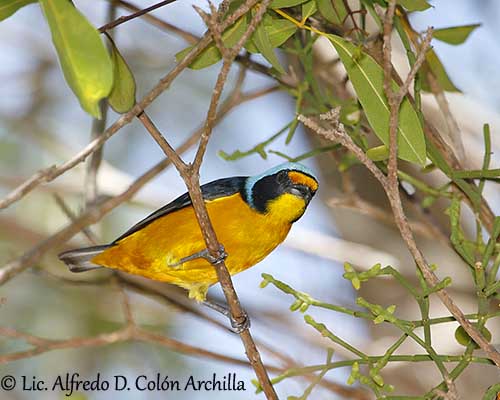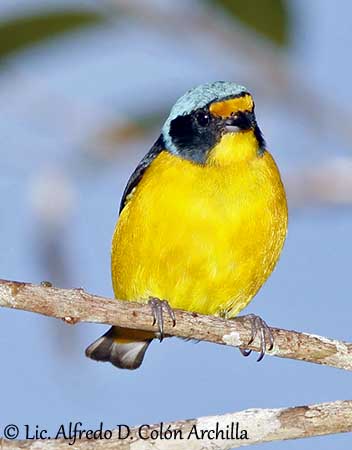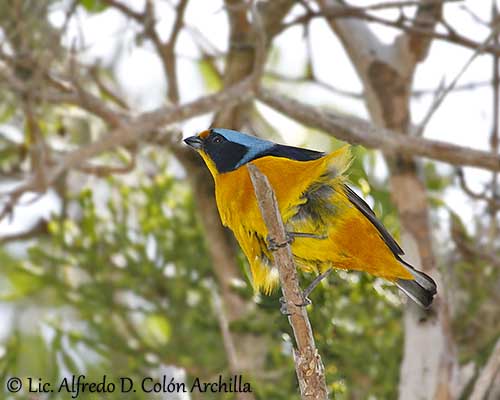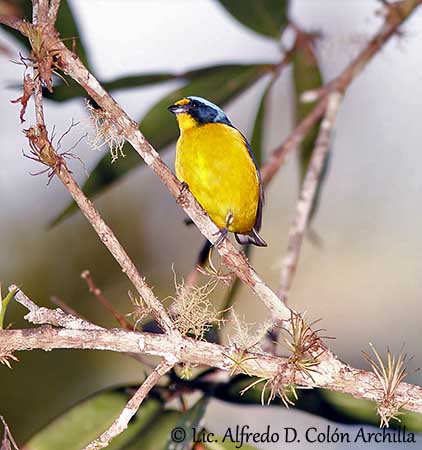
Fr: Organiste louis-d’or
Ang: Antillean Euphonia - Jilguero del País (Puerto Rico)
All: Antillenorganist
Esp: Eufonia Antillana
Ita: Eufonia delle Antille
Nd: Antillenorganist
Sd: Antilleufonia
Photographer:
Alfredo Colón
Puerto Rico Wildlife
Text by Nicole Bouglouan
Sources:
HANDBOOK OF THE BIRDS OF THE WORLD Vol 16 by Josep del Hoyo- Andrew Elliot-David Christie – Lynx Edicions – ISBN: 9788496553781
BirdLife International (BirdLife International)
Aves de Porto Rico – Sociedad Ornitológica Puertorriqueña
Neotropical Birds – Cornell Lab of Ornithology
SORA Searchable Ornithological Research Archive (Blair O. Wolf)
Antillean Euphonia
Euphonia musica
Passeriformes Order – Fringillidae Family
INTRODUCTION:
The Antillean Euphonia was formerly in the family Thraupidae, but after recent molecular genetic analysis, the genus Euphonia is now included in the family Fringillidae.
This species occurs in various types of forests where it is more often heard than seen, in spite of its brightly coloured plumage.
DESCRIPTION OF THE BIRD:
Biometrics:
Length: 10 cm
Weight: 12-16 g
The adult male of nominate race has contrasted upperparts with black mantle and back with blue gloss, and deep yellow rump and uppertail-coverts. The tail is duller black. On the upperwing, coverts and flight feathers are dull black. The wing-coverts show dark blue gloss, whereas the flight feathers show faint paler blue edges.
The underparts are deep yellow.

E.m. sclateri - Male
Puerto Rico
On the head, the forehead is yellow. Lores, ear-coverts, head sides, chin and throat are blackish-violet. Crown and nape are bright sky-blue, extending down and joining the throat base. Forehead and crown are separated by black band from eye to eye.
The bill is black. The eyes are dark brown. Legs and feet are dark grey.
The female is duller and paler than male. She has olive upperparts and yellowish to dull olive underparts, including chin and throat. On the head, the forehead is paler yellow, whereas crown and nape are dull bluish.
The juvenile resembles female but it is duller overall.
SUBSPECIES AND RANGE:
The Antillean Euphonia has three recognized subspecies.
E.m. musica (described) is found on Hispaniola and Goñave Island.
E.m. sclateri (displayed) occurs in Puerto Rico. This race has slightly deeper yellow forehead, bright yellow rump and underparts. Chin and throat that are paler yellow instead of black
E.m. flavifrons is found on several islands of the Lesser Antilles. In this race, the male resembles nominate female with olive upperparts, blue crown and nape and small yellow forehead patch. The underparts are olive-yellow with slightly paler and yellower throat and belly.
HABITAT:
The Antillean Euphonia frequents mountain forests, dry scrub forests and shaded coffee plantations in Puerto Rico.
This species occurs from lowlands to high mountains throughout the range and frequents dry to humid forests and can be seen along the edges and in disturbed areas with mistletoe. This species breeds mainly at high elevation.

E.m. sclateri - Male
Puerto Rico
CALLS AND SONGS: SOUNDS BY XENO-CANTO
The Antillean Euphonia was locally trapped as cagebird for its melodious song, a repeated “titititi” followed by a longer “zeeeeeeeeeeee”. This song may last up to 20 minutes with little or no pause, and it sounds like a tiny bell.
While foraging, the bird utters some calls, a plaintive whistle “whee”, a scolding “chit-it”, a metallic “chi-chink” and a softer “tuc-tuc”.
Both sexes in flight often give a sharp whistle and several notes forming chatter.
BEHAVIOUR IN THE WILD:
The Antillean Euphonia feeds primarily on small fruits from several plant species depending on the range. In Puerto Rico, it feeds mainly on mistletoe fruits (Phoradendron species). They feed in small flocks and forage in a clump of mistletoe before to fly over some distance to another clump. The fruits are plucked while the bird is perched or taken while hovering in front of the plant.
This species takes an active part in dispersal of the seeds of the parasitic mistletoe to different tree species. However, they may take seeds and fruits from other plants species, and especially Cecropia peltata, and some insects can be gleaned from foliage.
They usually remain among the dense foliage and move mainly at treetops. Only calls and flight pattern allow identifying them.

E.m. sclateri - Male
Puerto Rico
During the breeding season, courtship feeding from male to female is recorded. The male may occasionally bring food to the nest, prior to egg-hatching.
Outside the breeding season, they spend the day and roost in groups of up to 12 individuals.
The Antillean Euphonia is mostly resident. They perform seasonal movements between mountains and lowlands, and some intra-island movements are observed.
This species performs an undulating flight while foraging from clump to clump. It usually flies high in the forest canopy.
REPRODUCTION OF THIS SPECIES:
The breeding season takes place between January and July.
The nest is a domed structure with side entrance. It is well-concealed among the dense vegetation, usually tree epiphytes. It is made with moss and rootlets. The interior is lined with dried grasses and pieces of plant materials. It can be built from ground level to tall trees’ canopy. Both sexes build the nest.

E.m. sclateri - Male
Puerto Rico
The female lays 3-4 white eggs with reddish-brown markings. The incubation is often undertaken only by female and appears fairly long, ranging from 18 to 20 days. The chicks are fed by both parents, mainly with fruit pulp regurgitated by the adults. The chicks are feathered about 15 days after hatching and they leave the nest between 17 and 24 days of age.
PROTECTION / THREATS / STATUS:
The Antillean Euphonia has restricted range but it is common in most parts except in the Lesser Antilles where it is uncommon. The species is threatened by deforestation in Haiti. The race “flavifrons” appears in decline over much of the range.
The population is suspected to be stable, although some decline may occur depending on the range. After being trapped for cagebird trade, the Antillean Euphonia is now protected by law in Puerto Rico.
The species is currently evaluated as Least Concern.